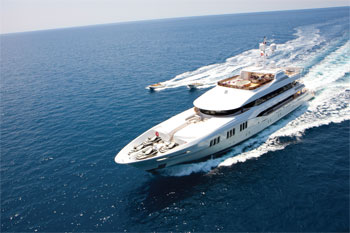The notion that form must follow function is both a necessity and a challenge when it comes to mega-yachts. Today's yachts must not only be equipped with the latest in luxury amenities, meet the space and layout requirements of their demanding owners, boast impressive, fuel-efficient performance, and adhere to the stringent safety requirements of the classification societies; they must also be aesthetically pleasing.
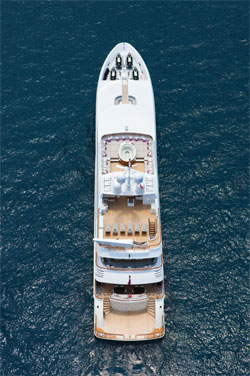 |
|
Courtesy Trinity Yachts/Kristina Strobel photos |
|
In four months the boat had already logged 9,600 miles. |
It's no coincidence that the world's foremost yacht builders have met this challenge through an inherent understanding of commercial shipbuilding. Such is the case with Trinity Yachts, based in Gulfport, Miss., whose commercial and military shipbuilding business and heritage have set its megayachts apart from the competition and kept the yard afloat during the ebbs and flows of the megayacht industry. This year, this most prolific yacht builder in the United States launched yet another vessel that sets a benchmark in technical systems, naval architecture and interior design: the 191-foot Carpe Diem.
The third yacht of the same name for an American customer, Carpe Diem is the owner's largest and his first custom build. He asked Trinity to incorporate the best and most advanced safety, mechanical and monitoring systems. The owner had big plans for cruising, so he and his longtime captain, Ryan Butterwick, worked with Trinity's in-house naval architecture and engineering team to incorporate the yard's latest super-performing hull design. He then turned to Carol Williamson & Associates of Portland, Ore., to create an interior style and layout that suited his family's lifestyle.
The quad-deck, ABS-classed Carpe Diem sleeps 12 guests in an on-deck master suite and four king-sized guest staterooms on the lower deck. Twelve to 16 crewmembers are housed forward on the lower deck in four bunks with generous headroom, while the captain's quarters are just aft of the pilothouse on the bridge deck. The pilothouse is equipped with state-of-the-art communication and navigation technology, including two GPS units, two VHFs, a single sideband radio, and all of the redundant systems necessary for long-term cruising.
Automatic watertight doors that close to give one-compartment flood-ability, a mist fire-suppression system and an emergency 99-kW Northern Lights generator are a few of the safety systems incorporated to meet the requirements for yacht charter of the Maritime and Coastguard Agency (MCA), the U.K. arbiter of safety standards. However, they are disguised in such a way that a guest would not notice. Most of the systems can be controlled from the pilothouse, including the numerous firefighting stations.
"One of the biggest challenges when building a luxury yacht is incorporating all of the safety requirements and still maintaining a finessed appearance," said Trinity Vice President Billy Smith, noting the uproar in the yachting world when MCA proposed that luxury yachts carry orange lifeboats. Designers scrambled, and most lifeboats are now disguised in white containers on the upper deck. Carpe Diem's rafts are nestled in pockets on the sundeck hardtop so as to not take away from the yacht's streamlined profile and are designed to pop free or be deployed hydraulically.
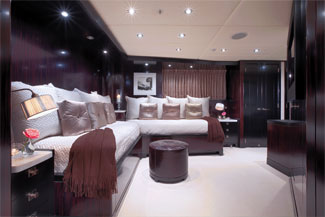 |
|
One of the four king-sized guest staterooms on the lower deck. |
Smith notes that the yard has learned through in-house engineering and feedback from yacht crews which systems work best in megayachts.
"In the early boats we made the mistake of incorporating seawater piping like commercial," he said. "When we had to replace it, it was so hard to access — unlike in commercial boats, where the systems can be easily accessed and quickly repaired. On a yacht, replacing a $10 pipe fitting might cause damage to a $4 million interior."
Carpe Diem's seawater piping is all welded cupronickel and, as with many megayacht systems, it not only meets ABS standards, it exceeds them. Sound deadening is found throughout — a feature now moving to the commercial sector due to Occupational Safety and Health Administration regulations.
Outfitted with the latest in electronics and entertainment systems, Carpe Diem also makes a statement with its interior design and decor, a salute to Art Deco. The unique, athwartships arrangement of the master bed in the master suite adds space for a sitting lounge and will certainly set a trend, as will the well-thought-out crew areas, designed for efficient and unobtrusive guest service.
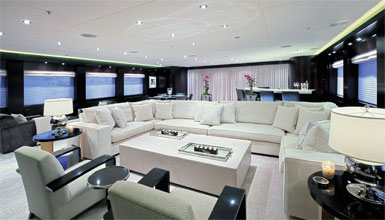 |
|
Courtesy Trinity Yachts/Kristina Strobel |
|
From sky lounge to dining table, designing yachts calls for elegance and grace, said Trinity’s Smith. “The commercial market is purely objective. Yachts are subjective.” |
Capt. Butterwick has the most to say about what sets this build apart from its peers. On the phone from Naples, Italy, just four months after leaving the Trinity yard, Butterwick calculates how far the yacht has traveled already.
"We've logged about 9,600 miles to date and could easily log 20,000 this year," he said. "We did 4,700 miles in 12 and a half days with only two fuel stops."
Butterwick spent more than five years on the owner's previous 150-footer before building the latest Carpe Diem. "It's like night and day with this one," he said. "She idles at 8 knots at 650 rpm; I could probably go around the world with the fuel capacity."
Carpe Diem features a semi-displacement hull design yielding an eight-foot draft to allow access to anchorages in the Bahamas. Like most Trinity yachts, it benefits from a strong, heavily plated hull. "We built our first explorer yachts to ABS," said Smith. "But when we went to ABS scantlings, the approved hull thickness showed some distortion when we welded the plate. On the second hull the owner requested ABS ice class "D" classification, and we were pleasantly surprised to find no distortion with the 5/8-inch and half-inch hull plating. We now will use ice-class scantlings for hull plating on future explorer yachts to hide any distortion. Here is a situation where you've added strength, but it's for cosmetic reasons."
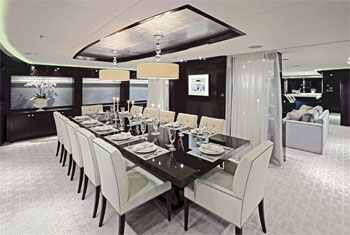 |
|
Courtesy Trinity Yachts/Kristina Strobel |
Trinity also capitalized on its expertise in building fast patrol and supply boats. "It's all about bottom loading," said Smith. "It all depends on the displacement, the power needed and the hull shape." Fast supply boats are equipped with hatches to allow a dead engine to be "swung out" overnight. While this is not feasible in large yachts, Carpe Diem's engine can be extracted through the hull side or bottom in the event a replacement is necessary.
This thinking extends to the rudder system as well, set slightly outboard of the propeller shaft so it's not necessary to drop the rudders to remove the propeller shafts. Most yachts' are in line and require the dismantling of the entire steering system for shaft repair.
"The big difference (between building private and commercial) is that we spend a lot of time designing and engineering the stability systems on the yachts," said Smith. The yard's largest build, the 242-foot New Horizon, will feature an electric stern thruster with the ability to maintain the most comfortable heading while the vessel is anchored, enhancing the vessel's "zero speed" stabilization system.
"The next step up is a simpler version of the DPS concept," Smith explained. "We can upgrade the bow or stern thruster to be directional, and then a third generator runs the thrusters. This is more of an 'electronic anchoring' system and not true DPS. When transferring technology, sometimes it's simplified and sometimes it's made much more complicated to suit the yachts. In this case it's simplified — our yachts don't need full DPS systems because they won't normally be anchoring out when it's rough if the owner and guests are aboard."
"For the most part, yacht building is not a hotbed of research and development," Smith said. "The owners want to know what is the latest and greatest and then have it implemented, once it is proven. We usually take what we've learned from commercial and military, then blend it in, hide it, and make it elegant.
"The commercial market is purely objective and can be measured — how fast, how many people can it carry, how far can it go, etc. … Yachts are subjective. You may have a boat that is faster, but the wife doesn't like the shape of the windows, or the owner wants a plumb bow or a bigger swim platform. That was the hardest thing that (Trinity) had to overcome. We entered into the yacht market because we had unutilized shipyards. Now that the yacht market has finally slowed down, we're going back to our roots of having a more balanced portfolio."
At 548 long tons, Carpe Diem is as strong as most commercial ships, yet designed from interior to exterior to be elegant and graceful. If its satisfied owner is any indication, the experience gained by yards like Trinity will only benefit future megayacht designs, builds and owners alike.

